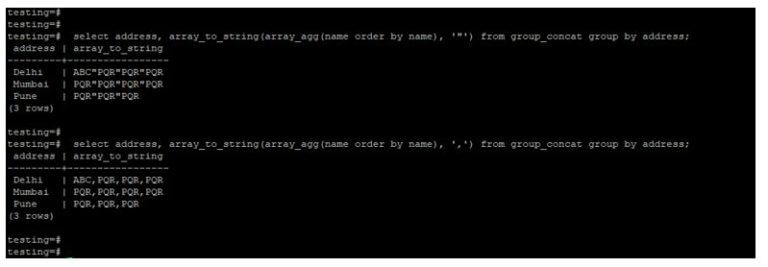

Maybe? Choosing the right abstractionįor your needs is important. You can then quickly findĪll children from a node by querying for the ids of theĬhildren contained in that node's children array. Store the direct or total set of children on each node and (which is true of most data, in my experience). Tree-structured data that is read more often than updated Not particularly efficient in terms of query writing or Well-suited for dealing with data in tree form. To create such an 15:07:54) > create index idx_array_test on array_test using gin (vals) Over hundreds of millions of results is still quite performant. Indexes on arrays in postgres! A query like the above Inserting array 13:57:05) > insert into array_test (vals) values (''Īnd you can simply add more tags or specify that multiple We don't need a primary key, but it will help with the
#Postgresql array functions serial#
Here's how you create a table with an array column 13:55:54) > create table array_test (id serial primary key, vals text) Any non-array concrete type can be used as the type SQL, being strongly typed, allows for only heterogeneousĪrrays. In array_to_string, if the null-string parameter is omitted or NULL, any null elements in the array are simply skipped and not represented in the output string."the world's most advanced open source database".īut what makes it so advanced? In this post, we'll beĬovering what may be my favorite feature: arrays.Īrrays allow you store lists of values in a single column. In string_to_array, if the null-string parameter is omitted or NULL, none of the substrings of the input will be replaced by NULL. Otherwise the input string is split at each occurrence of the delimiter string. If the delimiter is an empty string, then the entire input string is returned as a one-element array. In string_to_array, if the delimiter parameter is NULL, each character in the input string will become a separate element in the resulting array. This is only allowed in the FROM clause see Section 7.2.1.4 String_to_array('xx~^~yy~^~zz', '~^~', 'yy')Įxpand multiple arrays (possibly of different types) to a set of rows. Splits string into array elements using supplied delimiter and optional null string Returns the total number of elements in the array, or 0 if the array is empty Returns upper bound of the requested array dimension Replace each array element equal to the given value with a new valueĪrray_to_string( anyarray, text )Ĭoncatenates array elements using supplied delimiter and optional null stringĪrray_to_string(ARRAY, ',', '*') Remove all elements equal to the given value from the array (array must be one-dimensional)Īrray_replace( anyarray, anyelement, anyelement) Returns lower bound of the requested array dimensionĪppend an element to the beginning of an array Returns the length of the requested array dimension Returns an array initialized with supplied value and dimensions, optionally with lower bounds other than 1 Returns a text representation of array's dimensionsĪrray_fill( anyelement, int, ]) Returns the number of dimensions of the array See Section 8.15 for more information and examples of the use of these functions. Table 9-46 shows the functions available for use with array types. See Section 11.2 for more details about which operators support indexed operations. See Section 8.15 for more details about array operator behavior. (This is a change from versions of PostgreSQL prior to 8.2: older versions would claim that two arrays with the same contents were equal, even if the number of dimensions or subscript ranges were different.) If the contents of two arrays are equal but the dimensionality is different, the first difference in the dimensionality information determines the sort order. In multidimensional arrays the elements are visited in row-major order (last subscript varies most rapidly). Array comparisons compare the array contents element-by-element, using the default B-tree comparison function for the element data type.


 0 kommentar(er)
0 kommentar(er)
